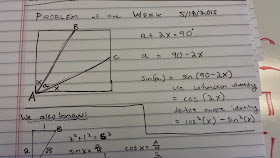 |
| Click to expand! |
A geometry and trig problem! We haven't seen one of these in a while. There are several ways to solve this problem, and I'll show just one of them below...
 |
| Click to expand! |
Above is the first half of my solution. I started by identifying that the two other angles making up the corner are equivalent. That means that a plus two copies of what I labeled x are equal to 90 degrees.
Then, I made sure my calculator was set to degrees mode because there are a bunch of trig identities in the works. I manipulated the equation until I reached the bottom line on the right, an equation that looks fairly easy to work with.
 |
| Click to expand! |
Below the line, I started to look at the triangles on the left and bottom sides of the square. I assigned a length to the square's side: 2 units. Because B and C both lie on the midpoint of their respective sides, that makes the side opposite angle x equal to 1 unit in length. After the pythagorean theorem, we recognize that the hypotenuse has a length of the square root of 5.
Then, I used our most basic trig rules of SOH CAH TOA to determine sin(x) and cos(x). After squaring each of these values, I plugged them back in to the equation from the right side of the paper, and found that sin(a) = (3/5) = 0.6. This means that a is equal to approximately 36.9 degrees.
Another method to solving this problem begins with the two outer triangles, and firstly identifying tan(x). I'm sure there are other methods as well. Let me know in the comments if you find anything, or, as always, let me know if you have any questions about the method I used to solve the problem!
-Tori
I used areas of triangles (area_ABC is square minus three right triangles) and got to the same answer with easier trig (but less glamour!)
ReplyDeleteI like your trigonometric solution. Alternatively, extend line AB and make a line perpendicular to AC at C. If A = (0,0), B=(4, 8), and C=(8, 4), the lines meet at (5, 10). Then the distance formula can be used to get a ratio of opposite / hypotenuse.
ReplyDeleteIf you solve for AC, AB, and BC (all using distance formula) and use the equation from the Law of Cosines, you can solve for cos(a) directly, and then use an identity to solve for sin(a) = 3/5.
ReplyDelete